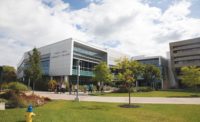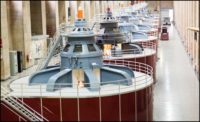The National Air and Space Museum (NASM), among the most popular museums in the world, opened in 1976 as part of the U.S. bicentennial celebration. Set along the National Mall in Washington, D.C., the museum welcomes approximately 7 million visitors annually to see such iconic artifacts as the 1903 Wright brothers plane; Charles Lindbergh’s Spirit of St. Louis; John Glenn’s Mercury capsule, Friendship 7; and the Apollo 11 command module. The building is massive in size, spanning three city blocks with 687,000 square feet of exhibition, theater, office, and support space.
After more than four decades of use, the sprawling complex was in dire need of an update. Quinn Evans was selected as the architect for a multiphase modernization of the NASM building with Mueller Associates providing mechanical, electrical, and plumbing (MEP) engineering. Now under construction, the renovation will upgrade a deteriorating roof and façade and remedy problems, such as too much light permeating the galleries, leaky pipes, inconsistent temperature and humidity, and limited accessibility. The work includes primarily new HVAC, plumbing, electrical, and life safety systems.
MODELING: INFORMING THE DESIGN
Our design team relied heavily on advanced modeling tools to inform the architectural and HVAC design, focusing on optimizing energy efficiency, visitor comfort, and the long-term protection of artifacts. A comprehensive Revit® building information model (BIM), which details the museum’s spaces, equipment, and finishes, will serve as an ongoing facility management tool.
Many advanced diagnostic and analytical tools aided the design process, including color laser scanning, energy modeling, envelope modeling, computational fluid dynamics (CFD), nondestructive testing, temperature and humidity monitoring, and daylight modeling. Temperature and humidity control was vital to the modernization design to support the conservation of artifacts, which require limited fluctuations in temperature and humidity. For years, condensation from the original envelope design hindered proper humidification in the building.
The energy model demonstrated that allowing a limited amount of seasonal variation in space temperature and relative humidity would be the single biggest contributor to energy savings, amounting to nearly 20%. The use of LED lighting with daylight sensors would be the second largest contributor. The energy model assisted the design team in the selection of several different systems, ultimately demonstrating a 47% site energy use intensity (EUI) reduction when compared to the International Association of Museum Facility Administrators’ benchmarking survey data and a 39% source EUI reduction.
Two software products were used in the assessment of the building envelope. Wärme Und Feuchte Instationär (WUFI), or “heat and moisture transiency” modeling, was used to evaluate vapor diffusion and moisture transport in the building materials. THERM, developed by the Lawrence Berkeley National Laboratory (LBNL), enabled the design team to model two-dimensional heat transfer effects in building components, such as the glass curtain walls and stone-clad walls. These models informed decisions regarding the amount and placement of insulation as well as glazing and associated frame selection for curtain walls and skylights.
The CFD assessed the building’s thermal environment, including temperature and airflow. This data informed the location of new heat sources throughout the galleries. Many artifacts are suspended at varying heights in NASM’s 60-foot-tall skylit atrium galleries, enabling visitors a dramatic view of the air and spacecraft against the backdrop of the sky. This bold and unique design feature has posed problems in terms of the stratification of temperature-controlled air. CFD modeled the convective currents to determine optimum locations for air diffusers and helped identify remedies to prevent condensation from occurring on the surfaces of the skylights and curtain walls through the appropriate positioning of radiators along the floor and midway up the walls. It also informed the placement of air devices to reduce stratification.
As in most museums, it is imperative to limit excessive light, including visible, infrared, and ultraviolet, to protect artifacts. It is well-known that UV light can be very damaging to artifacts, but, actually, all light can contribute to artifact deterioration. A daylighting model, which assessed light exposure at different times of the year, helped the team devise a daylighting protection strategy, including a combination of tinted fritted glass and interior shading devices. The use of shades integrated with dimmable lighting permits controlled artifact light levels to a much more tolerable level. Three types of fire models were also developed, including a conventional fire egress model.
PROTECTING ARTIFACTS WHILE KEEPING VISITORS COMFORTABLE
NASM, like many buildings on the National Mall, was served by the U.S. General Services Administration’s (GSA’s) chilled water and steam systems. Through energy modeling and life cycle cost analysis, the new heating and cooling plants were optimized to both improve efficiency and increase resiliency by providing plants with the building. New Fulton condensing hot water natural gas-fired boilers provide the entire heating capacity with N+1 redundancy, which will eliminate the need for GSA steam in the main building. The new boiler system is scheduled to pay for itself in less than two years.
For the cooling plant, a hybrid approach combined a large Trane variable-speed, high-efficiency centrifugal chiller; Trane-dedicated heat recovery rotary chiller; and GSA chilled water. Although the chiller plant capacity is only half the peak load, it will provide more than 80% of the chilled water capacity throughout the entire year, with the GSA chilled water service providing the peak capacity when needed. Simultaneously, the dedicated heat recovery chiller condenser heat rejection provides more than 80% of the heating water capacity throughout the entire year.
Variable flow primary distribution systems will be provided for both the chilled water and heating water systems via Bell & Gossett base-mounted pumps. Tranter plate and frame heat exchangers separate the district GSA chilled water loop from NASM’s internal chilled water loop and permit heat rejection from the dedicated heat recovery chiller to the Evapco counterflow cooling towers during low chilled water loads when heating is not required.
Distribution options for the galleries were studied extensively. A high-performance variable-air volume (HPVAV) system with a dedicated outdoor air system (DOAS) pretreatment, air-side enthalpy energy recovery, adiabatic humidification, MERV-15 filters, and demand-based control strategies will be provided. The use of a DOAS addresses the gallery’s dehumidification loads, which frequently permit the air-handling units (AHUs) to reset the supply air temperature based on the space sensible cooling loads and drastically reduce the need for reheat. Limited space in the basement required many of the Air Enterprise AHUs to be assembled in the field, which requires factory technician field supervision and testing.
The Siemens demand-based controls constantly monitor the space’s CO2 levels, chilled and heating water pressure independent control valve positions and differential pressures, damper positions, space conditions, outside airflows, supply airflows, and supply air static pressures to reset equipment set points and only deliver the energy required to satisfy the demand.
RAINWATER HARVESTING
Nearly four acres of the site — approximately 165,000 square feet — consist of roof and terrace areas. The large expanses of impervious materials provide an ideal opportunity for rainwater harvesting. Two 100,000-gallon concrete cisterns will be located at the east and west ends of the building to collect rainwater runoff. The cisterns are estimated to collect approximately 4.4 million gallons of rainwater a year. The harvested runoff is used for irrigation, cooling tower makeup water, and toilet and urinal flushing.
Here, as in many other aspects of design, modeling and coordination with the other design disciplines was vital. Rainwater from the roof and skylight drains, as well as air conditioning condensate, will enter the harvesting system, where the water will be conveyed to the basement mechanical room and parking garage areas. It will then be piped through vortex filters to provide prefiltration and remove debris.
The filtered water will be piped to the underground cisterns, where duplex pumps will then convey the water to four 1,500-gallon day tanks within a basement mechanical room. The water will be pumped from the interior day tanks and recirculated through a self-cleaning filter and UV treatment before routing to the end use. Additional equipment includes quadplex booster pumps with variable frequency controllers and a hydro-pneumatic tank, piping headers, and a control panel tied to the building management system interface.
DOMESTIC WATER SERVICE
In all, more than 20 miles of new plumbing piping is being installed in the NASM building, including piping for the rainwater harvesting gravity drain system; distribution of the filtered, nonpotable water; domestic hot, cold, and hot water recirculating piping; and sanitary and vent piping to and from the plumbing fixtures.
Two new water service entrances and associated reduced pressure zone (RPZ) backflow preventers (BFP) will replace existing components in approximately the same location. The two new RPZ BFPs will include automatic shut-off valves that prevent water flow to the building if the flow is sensed as being discharged through the relief chambers and subsequently into the basement. Alarm signals from each RZP BFP will be connected to the building automation system (BAS).
Water service will include duplex stainless steel bag filters sized for 600 gpm. A triplex domestic water booster system will be provided to increase potable water system pressure in the building to serve sinks, showers, electric water coolers/bottle fillers, and other fixtures requiring potable water, such as the domestic hot water system, mechanical system make-up, and water reclamation/harvesting back-up supply, when needed. The triplex pumping system includes variable frequency controllers, a hydro pneumatic tank, and a control panel with BAS interface.
Building water meters will be provided in each water service main with valved by-passes. Separate water meters will be provided for irrigation and each mechanical system make-up water connection as well as the water reclamation/harvesting system. Water meters will be monitored by the BAS.
Additional meters for the water utility will be provided for billing both water consumption and sanitary sewage usage and will also be monitored on the BAS.
A VALUABLE PROCESS
The modernization has been designed to LEED Gold standards and is currently tracking a 38% reduction in greenhouse gas emissions (CO2). With extensive modeling and analysis, the Smithsonian Institution anticipates using the project as a pilot for future construction projects within its vast building inventory — 19 museums and nine research centers. The phased construction, which is allowing the building to remain open to visitors, is expected to be completed in 2025.









